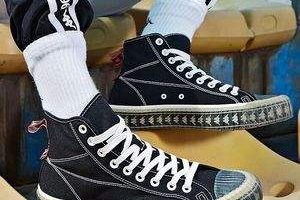Introduction
Japan, a land where tradition and modernity seamlessly intertwine, possesses a captivating shoe culture that has evolved over centuries. This comprehensive article delves deep into the history and inheritance of local shoes in Japan, the contemporary styles favored by modern locals, the preferences of different generations – from the elderly to children and young adults, the presence of local and global shoe brands, sales trends of major shoe brands in Japan, and the emerging trends in local Japanese shoes. Join us on a comprehensive journey through the intricate world of Japanese footwear culture.
A Glimpse into the History and Inheritance of Japanese Shoes
Japanese shoe culture is deeply rooted in tradition, representing a unique blend of function, form, and cultural significance. It has been molded by the country’s history, customs, and diverse regions.
Traditional Japanese Shoes
Traditional Japanese shoes are emblematic of the nation’s rich heritage. Some of the most iconic styles include:
- Geta: These wooden sandals, elevated on wooden stilts, are an integral part of Japanese culture and are often worn with traditional clothing such as kimono and yukata.
- Zori: Zori are flat, straw sandals, commonly associated with formal attire.
- Tabi: Tabi socks, with their distinctive split-toe design, are a fundamental part of traditional Japanese footwear.
Cultural Significance
Traditional Japanese shoes carry profound cultural significance. They are more than mere accessories; they are symbols of seasons, occasions, and ceremonies. For example, different styles of geta are worn during various seasons, and tabi socks are essential for tea ceremonies and other formal events.
Modern Preferences in Japanese Shoe Culture
As Japan has embraced modernity, the footwear culture has also transformed to reflect contemporary tastes and lifestyles.
Traditional Styles in Everyday Life
While traditional Japanese footwear is less common in daily life, many Japanese people still embrace geta and zori on special occasions, such as festivals and ceremonies, to preserve cultural traditions.
Contemporary Fashion Footwear
Modern Japanese locals have a penchant for stylish and comfortable footwear. This has given rise to a thriving market for contemporary shoe designers who seamlessly blend traditional elements with modern aesthetics, offering a wide range of fashionable shoes for everyday wear.
Generational Preferences in Shoes
Japanese shoe culture is diverse and dynamic, reflecting the unique preferences of different generations.
Elderly Population
The elderly in Japan often prefer comfort and practicality. Orthopedic shoes, supportive slippers, and traditional zori sandals are common choices for this generation, reflecting their emphasis on health and comfort.
Children’s Footwear
Children’s shoes in Japan prioritize durability and practicality. School shoes, known as “randoseru,” are iconic for their boxy, leather design, providing sturdy support for young learners.
Young Adults
Young Japanese adults have a wide range of preferences, from sneakers to stylish boots. Sneakers have become a staple in their wardrobes, with many enthusiasts collecting limited-edition and trendy styles.
Local Japanese Shoe Brands
Japan’s footwear industry is robust and diverse, with a blend of local craftsmanship and global brands catering to varied tastes.
Traditional Craftsmanship
Japan is renowned for its craftsmanship, and many local shoe brands emphasize traditional Japanese techniques and materials. These brands often produce high-quality, handmade shoes that are appreciated both domestically and internationally.
Global Presence
International shoe brands, from luxury labels to athletic footwear giants like Nike and Adidas, have a significant presence in Japan. They offer a wide range of options to cater to diverse consumer preferences.
Sales Trends in the Japanese Shoe Market
The Japanese shoe market is a dynamic and competitive space with several noteworthy trends.
Sneaker Culture
Sneakers have taken Japan by storm, driven by both comfort and style. Collectible and limited-edition sneakers often create a frenzy among Japanese consumers, especially the younger demographic.
Sustainable and Ethical Footwear
Environmental consciousness is on the rise, and Japanese consumers are increasingly seeking sustainable and ethically produced footwear. Brands that prioritize eco-friendly materials and ethical practices are gaining traction.
Emerging Trends in Local Japanese Shoes
Japanese shoe culture continues to evolve, with several new trends shaping the industry.
Fusion of Tradition and Modernity
Designers are exploring the fusion of traditional Japanese motifs and materials with modern designs, creating unique and culturally rich footwear that appeals to a broad spectrum of consumers.
Minimalist and Functional Designs
Many Japanese consumers, particularly young adults, appreciate minimalist and functional shoe designs, reflecting the country’s aesthetic sensibilities and emphasis on practicality.
Conclusion
Japanese shoe culture is a multifaceted tapestry that interweaves tradition, modernity, and generational preferences. From the rich history of traditional footwear with deep cultural significance to the vibrant market of stylish and comfortable contemporary shoes, Japan’s shoe culture is a testament to its cultural heritage and forward-thinking fashion. The presence of both local craftsmanship and global brands, the popularity of sneakers, and the emphasis on sustainable footwear highlight the diversity of the Japanese shoe market. As Japan continues to influence global fashion trends, its shoe culture will remain a vital part of its cultural legacy and a source of inspiration for fashion enthusiasts worldwide. Understanding the intricacies of Japanese shoe culture is not only an exploration of its past but also an appreciation of its enduring impact on the world of fashion, spanning across generations.
















Add Comment